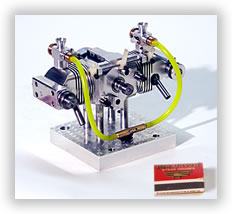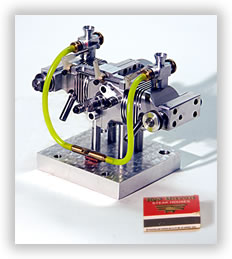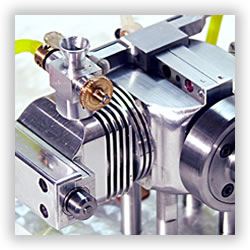
Above: right side view
Below: left side view

|
|
ENGINE NO. SEVEN DATA
Cylinders: 2
Type: Horizontal SOHC twin
Bore: 0.661 ”
Stroke: 0.625”
Displacement: .213 cu. in./cyl = .426 cu. in.
Compression Ratio: 7:1
Ignition: Glow plug
Cooling: Air
Fuel: 15% nitromethane/methanol mix
Max. RPM: (not yet run)
Est. Horsepower: (not run yet)
BUILDER'S
NOTES
Background — Since I hadn’t
built a horizontal twin engine, this seemed a good time
to attempt such a design. I had originally made a preliminary
sketch of such a beast but everything got out of hand as
I realized this engine would be about 12 in. across. This
seemed okay at first, but when I thought about hogging out
of the cylinders, etc. , it quickly began to seem unreasonable.
I figured that cutting the design in half would make it a reasonable
size, so I took that direction. As the construction progressed,
however, some of the parts became very delicate. I never designed
and built very small carburetors, for example. As you'll read
below, the whole scheme turned out to be very difficult.
Construction -- The basic
idea was to have each cylinder mounted together as a unit with
integral cylinders and heads. This made for a simple arrangement
that worked well enough. But each part of this little engine
turned out to be a challenge. For instance, the valves are
.187" in diameter with the stems .0625” dia. Each
part needed some careful study and ended up requiring special
procedures. In the case of the valves, I ended up using .0626” dia.
dowel pins for the stems with the valve heads silver-soldered
in place and the retainer grooves ground with a moto-tool cutoff
disc. Almost every part was
some oddball thing or another.
Operation -- So far, the operation
has been disappointing. The low compression may be part of
the problem. And perhaps the small valves, which are very
critical to performance. But I need to put more time in to
run some more tests and then see what modifications I might
want to make.
ON ENGINE STARTERS
In my early days with model airplane engines,
my usual starting system was to flip the propeller. That was
simple enough, although I have managed to split a few wood
props with my fingers. Later I used a small DC motor with a
rubber cup to engage the spinner. However, after I abandoned
my model airplane engines it was necessary to look for other
starting methods.
The eventual result was a one-way clutch
which could be held in a small drill motor. The clutch input
shaft was held in the chuck and the ooutputshaft which was
a ball type (Bondhus) hex shaft which engaged a hex socket
in the end of the motor shaft. This acted as kind of a universal
joint. The hex socket could be silver-soldered in the motor
shaft end. In some cases it is possible to only Loctite the
socket into the shaft. Unfortunately, since these engines
all run counter-clockwise (viewed from the output end), the
socked head screws want to unscrew. Left hand scews would be
nice. All in all, though, this system has taken a lot of the
sweat out of starting a balky engine.
|
|

Detail of SOHC head,
intake side.
ENGINE DETAIL PAGE LINKS
(click on buttons)
|